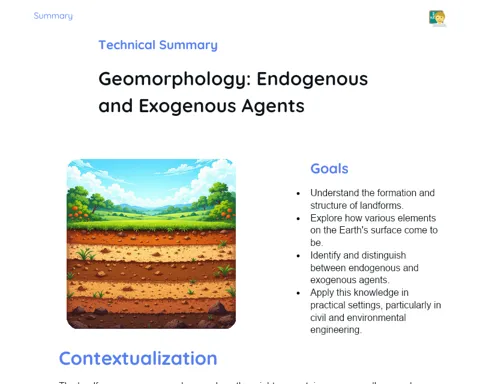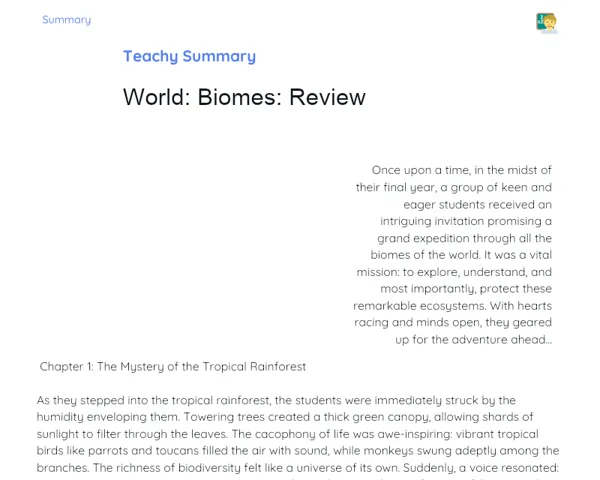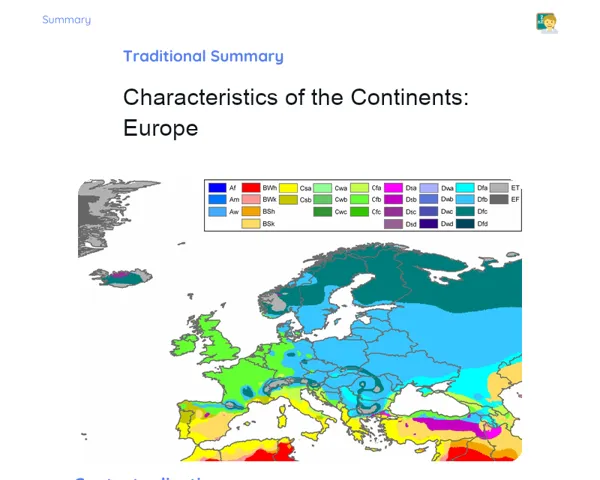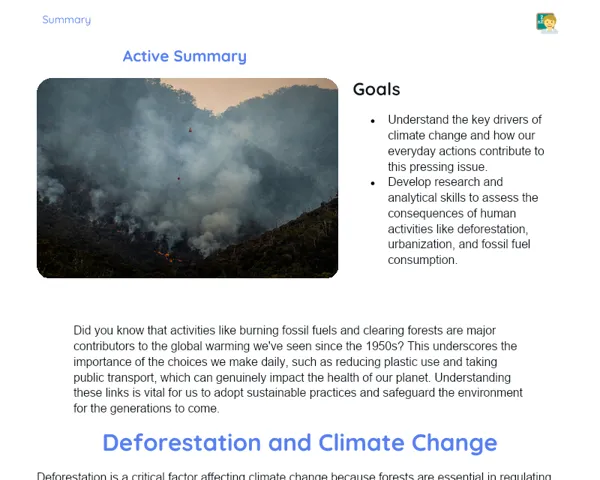Socioemotional Summary Conclusion
Goals
1. Grasp how atmospheric circulation along with wind and rain work, and how they shape our climate.
2. Appreciate the role of atmospheric elements in our day-to-day life and in making informed decisions.
3. Build socio-emotional skills such as self-awareness and emotional regulation when dealing with weather-related phenomena.
Contextualization
Have you ever paused to wonder why the wind blows or how exactly the rain comes about? These phenomena are more than just everyday occurrences; they are lifelines for our planet. By learning how atmospheric circulation functions and the role played by wind and rain, we can make better preparations for climate changes, choose our daily activities wisely, and even understand the impact of weather on our moods and feelings.
Exercising Your Knowledge
Atmospheric Circulation
Think of atmospheric circulation as the way air moves around because of differences in temperature and pressure. Much like a large boiling pot where the Sun heats parts of it unevenly, driving circulation currents that redistribute warmth, the Earth's atmosphere acts in a similar manner. These air currents not only help in regulating the climate but also influence a range of weather events—from a gentle breeze on a sunny day to heavy monsoonal rains.
-
Temperature Differences: The Sun heats different regions of the Earth unevenly, resulting in areas with varying temperatures.
-
Pressure Differences: Warmer regions exhibit lighter air (low pressure) while cooler regions have denser air (high pressure).
-
Air Movement: Air migrates from high to low pressure areas to balance these differences, thereby creating air currents.
-
Climatic Impact: This circulation is key to many climatic phenomena, including trade winds, monsoons, and even cyclones.
Wind
Wind is simply air moving from high-pressure areas to low-pressure areas. This process is nature’s way of balancing out the differences in temperature and pressure. Depending on the intensity of these differences, wind can be as mild as a soft evening breeze or as forceful as during a severe storm.
-
Atmospheric Pressure: The imbalances in pressure between regions create the movement of air, known as wind.
-
Wind Direction: Winds consistently flow from areas of higher pressure towards those of lower pressure.
-
Local Winds: Examples include sea breezes and land breezes, which occur due to temperature and pressure variations between the land and the sea.
-
Coriolis Effect: Due to the Earth’s rotation, winds are deflected slightly – to the right in the Northern Hemisphere and to the left in the Southern Hemisphere – which influences their overall path.
Rain Formation
Rain forms when warm, moist air rises, cools down, and condenses into tiny water droplets. These droplets gradually come together to form clouds, and eventually, when they become heavy enough, they fall as rain. This process is an essential part of the water cycle that replenishes our rivers, lakes, and groundwater supplies, much like the life-giving monsoons we depend on.
-
Rising Warm Air: Warm, moist air ascends because it is lighter compared to the colder air around it.
-
Cooling and Condensation: As this air rises, it cools down and the water vapour condenses into small droplets.
-
Cloud Formation: These droplets group together to form clouds.
-
Precipitation: Once these droplets grow large enough, they fall as rain, or in some cases, as snow or hail.
Key Terms
-
Atmospheric Circulation: The movement of air in the atmosphere induced by variations in temperature and pressure.
-
Wind: The movement of air from zones of high pressure to those of low pressure.
-
Atmospheric Pressure: The force exerted by the weight of air on the surface of the Earth.
-
Condensation: The process whereby water vapour changes into liquid droplets when cooled.
-
Precipitation: Any form of water, such as rain, snow, or hail, that falls from the sky.
For Reflection
-
How do you feel knowing that natural events like wind and rain have scientific explanations behind them?
-
What methods can you adopt to handle any frustration when trying to unravel a tricky geography concept?
-
In what ways might your understanding of atmospheric circulation help you make smarter daily choices, like picking the right attire for the weather?
Important Conclusions
-
Atmospheric circulation, wind, and rain are fundamental natural processes that help regulate our climate and directly impact both our daily routines and our environment.
-
Gaining an understanding of these atmospheric elements enables us to make informed decisions and better manage the changes in weather.
-
Knowledge about these processes can also support the development of socio-emotional skills, such as heightened self-awareness and improved emotional regulation, particularly during extreme weather events.
Impacts on Society
Today, a thorough understanding of atmospheric circulation profoundly influences society – from enhancing our weather forecasts to guiding daily planning and even supporting agricultural practices. By knowing how weather functions, we are better equipped to handle extreme events like storms or heatwaves that can affect our health and safety. Furthermore, the emotional bond we share with our weather is very significant in our context. Climate changes, as well as natural calamities, deeply affect our emotions and overall well-being. By deciphering these phenomena, we can nurture greater emotional resilience, become aware of our emotional responses, and find healthier ways to cope with stress during adverse weather conditions.
Dealing with Emotions
To manage your emotions while studying topics like atmospheric circulation, wind, and rain, consider trying an exercise based on the RULER method. Begin by noticing how you feel about these subjects—whether you are curious, puzzled, or a bit frustrated. Next, reflect on what might be triggering these feelings; sometimes complex subjects naturally lead to moments of frustration. Identify and name your emotions clearly, then try to express them constructively—be it through discussion with peers or jotting down your thoughts in a journal. Finally, learn to regulate these emotions by taking deep breaths or pausing for a short break during study sessions.
Study Tips
-
Develop mind maps to connect different atmospheric phenomena clearly.
-
Enhance your understanding by watching informative videos and documentaries on atmospheric circulation, wind, and rain.
-
Engage with online forums or form study groups to share insights and clear doubts with colleagues and experts in the field.



